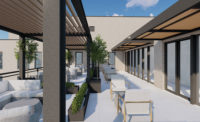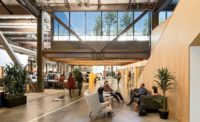Bay Area architects see their affordable housing work as part of a long tradition of progressive culture and urbanism.
That concern can spawn buildings where the aesthetic goal is to fade into the background—as is the case with many San Francisco affordable-housing projects from the 1980s and ’90s. Now, especially in more transitional districts, there’s a desire to make a splash, not just among bureaucrats or architects, but nonprofit developers who often represent a new generation of decision-makers.
One of Baker’s frequent clients is Citizens Housing Corporation, a 16-year-old company that has 23 complexes in the Bay Area with another five on the boards or under construction. Its president, James Buckley, has advanced degrees in planning and architecture from the University of California, Berkeley.
“There’s a split between generations of nonprofit developers,” suggests Baker. “The original idea was ‘let’s fit in at all costs, don’t stick out, don’t let architects victimize the poor with experimental designs.’ Younger project managers [at nonprofits] want to do something interesting.”
For a large block of San Francisco’s Mission District, Citizens Housing hired Daniel Solomon. While the architect is best-known as a cofounder of the Congress for New Urbanism, he and his firm (now WRT/Solomon E.T.C.) have worked on affordable projects dating back to the 1970s.
“It’s so much easier to do good architecture for nonprofit developers than for production builders. You aren’t forced to satisfy a bunch of marketer specifications,” Solomon says. Also: “You’re dealing with decision-makers, rather than layers of organization and committees.”
The Mission District project is called Mosaica, and it’s perched between the district’s heavily Latino residential blocks and a light industrial area that faces gentrification pressures. It opened this winter with for-sale condominiums, family apartments, senior studios, and 12 live/work spaces reserved for light industry or design production, the latter included to soothe critics of the conversion of a former blue-collar site.
Solomon’s architectural response to the jumble of uses was a rhythmic march of large bays and oversize details—such as a two-story-high terrace framed by arches—with a new alley to slice the block in two. The alleyway links Alabama and Florida Streets and is framed by live/work spaces with glass garage-door entrances and passes beneath portals created by third- and fourth-floor apartments.
With the large moves come small touches that bring different populations together. The two-story terrace adds depth to a long wall, but also serves as an enticing common space off a shared laundry room. And a community room is available for use by neighborhood residents as well. “It’s a big, simple building, but it puts together an extremely interesting mix of uses,” Solomon says. “They’ll thrive off each other and reflect what this neighborhood is about.”
Besides Solomon, other veterans of the affordable-housing scene are Oakland-based Michael Pyatok and San Francisco’s Bob Herman, whose firm (now Herman & Coliver: Architecture) since 1969 has designed 20 projects in San Francisco with roughly 1,700 units.
Herman’s most recent building is for the Salvation Army in the long-beleaguered Tenderloin neighborhood. Inside the grandly titled Ray & Joan Kroc Corps Community Center and Railton Place are 110 apartments, but also a Salvation Army facility complete with an indoor pool, computer labs, a dance studio, and a full-court gymnasium. The exterior’s restrained Modernism includes one jaunty touch: Shallow metallic bays angle out from a concrete facade in such colors as pure yellow and foam green.
“The Bay Area attracts inventive progressive people, idealists,” argues Herman, who taught at U.C., Berkeley’s College of Environmental Design for 20 years. “The best of my students are now the best of my competition. It keeps me on my toes.”
Wherever they went to school, the interest in affordable housing from younger Bay Area architects continues.
For a 15-story tower planned near San Francisco’s Civic Center, Citizens Housing and the Tenderloin Neighborhood Development Corporation has hired Sullivan Saida Design Partners—a firm with just 10 employees and only a handful of completed buildings.
“Affordable housing and the social aspect of architecture are things I’ve always been interested in,” says Mimi Sullivan, who grew up in the Bay Area and returned in 1999 at the height of the dot-com boom with her partner, Koji Saida. “I’ve seen the social landscape change so dramatically,” says Sullivan. “We’re losing a lot of interesting people.”
Citizens Housing president Buckley is happy to try fresh talent.
“David Baker was new at one point, and he has really blossomed,” he points out. “We need to be looking into the future.”






